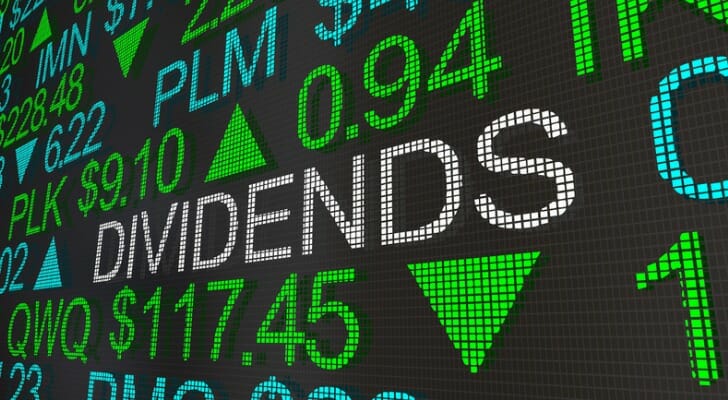Dividends are bonus payments companies give to stockholders, offering immediate income while you wait for potential future gains if the stock price rises. They serve as both a reward for investors and a confidence booster for the company’s stock. While investing in dividend-yielding stocks can provide extra income and an upfront return, it’s important to research which stocks pay dividends and how they’re taxed.
For help managing your investments, including dividends, consider finding a financial advisor to work with.
What Are Dividend Payouts?
Dividend payouts are payments that a company makes to its shareholders. They provide a way for companies to distribute their revenue among their shareholders after allocating enough money to business expenses and future development. They’re a great way for investors to generate income on a stock without buying or selling. Dividend payouts typically occur quarterly, but some occur on a monthly or yearly basis. Some dividend payments are non-recurring.
While dividends are usually distributed as cash, some companies provide extra shares as a dividend. Others offer dividend reinvestment plans (DRIPs), which allow shareholders to buy stock with their dividend at a discounted rate.
A company’s board of directors ultimately decides the details of each dividend payment. You’ll need to buy stock by a certain date to be eligible for a dividend payment. This date is called the ex-dividend date. The board decides the amount of the dividend when it will be paid and the ex-dividend date.
Dividends are paid per share. If a company announces a dividend payment of $0.15 per share and you own 100 shares, your dividend payment will be $15 and will be deposited into your brokerage account. Mutual funds and exchange-traded funds (ETFs) receive dividend payments and divide them up among their investors.
Dividend Payout Ratio?
The dividend payout ratio is the percentage of the total amount of dividends paid out to shareholders based on the company’s net income in any one period. This illustrates how much money is being paid to shareholders in comparison to the amount that’s being used to either reinvest into the company or to pay off debts.
To figure out the payout ratio of your dividends, follow the formula below:
- Dividends paid ÷ Net Income = Dividend payout ratio
Maintaining a high dividend payout ratio is often unsustainable for companies since it means less money is available for internal reinvestment. Larger, more established companies often boast high payout ratios, as they’re more likely to be beyond their expansion phase. Therefore, they are then able to return more revenue to shareholders instead of committing to reinvestment.
Dividend Payouts and Taxes
You’ll have to pay tax on dividend payouts. Ordinary dividends, which include dividends on employee stock options or real estate investment trusts, are taxed as normal income. Qualified dividends, which come from stocks that you’ve owned for more than 60 days within 121 days surrounding the ex-dividend date, are taxed as capital gains at a much lower rate. You’ll pay 0% if you make less than $39,375 per year, 15% if you make between $39,375 and $434,550 per year, or 20% if you make more than $434,550 per year.
When filing your taxes, you’ll be able to disclose cash dividend income on your 1040 Form on lines 3a and 3b. You’ll find the dividend amounts to report on your 1099-DIV. Stock dividends aren’t taxable until they’re sold.
Which Stocks Pay Dividends?
Big and well-established companies are much more likely to pay dividends. Such companies have less of a need to invest money back into their businesses. They can afford to reward shareholders without taking a hit. Faster-growing companies don’t usually pay dividends, as they tend to want to dedicate as much revenue as possible to growth and expansion.
Once companies start paying dividends, they’re unlikely to stop or change significantly. Changes in dividend payments can signal financial distress to investors and hurt a company’s stock price. That being said, just because a company has paid dividends in the past doesn’t mean that they’ll continue to pay them in the future. GE famously cut its dividend payments in half nearly a decade ago. As a result, their stock price dropped by 7%.
Since it’s often hard to sell investors on a reduction or cessation of dividend payouts once a company has started, it’s easy to understand why many companies elect not to pay dividends.
It can be helpful to talk to a financial advisor if you’re interested in researching and picking dividend-yielding stocks. Certain mutual funds and ETFs also pay dividends and are a solid option for anyone not looking to invest in individual stocks.
Bottom Line

Dividend stocks are a great option for generating income from your stock portfolio without buying or selling shares. Dividend-yielding mutual funds and ETFs also serve the same purpose. Make sure that you familiarize yourself with how companies usually pay their dividends. Finally, remember that companies aren’t obligated to pay dividends as they have in the past. You should still invest in companies you have confidence in, not just ones that pay dividends.
Tips for Investing in Dividend-Yielding Stocks
- A financial advisor can help you build a portfolio that balances, growth, safety and dividend income. Finding the right financial advisor that fits your needs doesn’t have to be hard. SmartAsset’s free tool matches you with vetted financial advisors who serve your area, and you can have a free introductory call with your advisor matches to decide which one you feel is right for you. If you’re ready to find an advisor who can help you achieve your financial goals, get started now.
- Dividend stocks can play a role in your retirement income, but they likely won’t be your sole source of income. Be sure to calculate your expected Social Security benefits, and use our retirement calculator to see how far your savings will take you.
Photo credit: ©iStock.com/iQoncept, ©iStock.com/ipopba, ©iStock.com/ipopba

